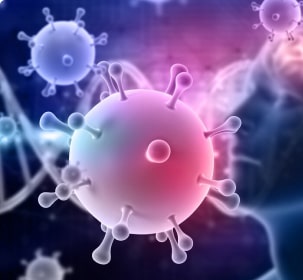Humans can be infected with avian influenza (AI) viruses including AI virus subtypes A(H5N1) and A(H7N9).
The majority of human cases of influenza A(H5N1) and A(H7N9) virus infection have been associated with direct or indirect contact with infected live or dead poultry. Controlling the disease in the animal source is critical to decrease risk to humans.
Influenza viruses, with the vast silent reservoir in aquatic birds, are impossible to eradicate. Zoonotic influenza infection in humans will continue to occur. To minimize public health risk, quality surveillance in both animal and human populations, thorough investigation of every human infection and risk-based pandemic planning are essential.

Signs and Symptoms in Humans
Avian influenza virus infections in humans may cause disease ranging from mild upper respiratory tract infection (fever and cough), early sputum production and rapid progression to severe pneumonia, sepsis with shock, acute respiratory distress syndrome and even death. The case fatality rate for A(H5) and A(H7N9) subtype virus infections among humans is much higher than that of seasonal influenza infections.
(WHO. Influenza (Avian and other zoonotic) Fact Sheet. 13 November 2018)
Vaccines
There is currently no vaccine for the prevention of avian influenza available in humans and it is difficult to develop a vaccine for AI because the virus is always changing. (WHO. Genetic and antigenic characteristics of zoonotic influenza A viruses and development of candidate vaccine viruses for pandemic preparedness. February 2023).
However, at least four biopharmaceutical companies have candidates that are being tested in animal and human trials. (Wu YL, Shen L-W, Ding Y-P. Preliminary success in the characterization and management of a sudden breakout of a novel H7N9 influenza A virus. International Journal of Biological Sciences, 2014, volume 10, number 1, pages 109-118.: Bart SA. et al. A Cell Culture–Derived MF59-Adjuvanted Pandemic A/H7N9 Vaccine Is Immunogenic in Adults. Sci Transl Med 30 April 2014: Vol. 6, Issue 234, p. 234ra55 ).
(Wu YL, Shen L-W, Ding Y-P. Preliminary success in the characterization and management of a sudden breakout of a novel H7N9 influenza A virus.)
International Journal of Biological Sciences, 2014, volume 10, number 1, pages 109-118. Bart SA. et al.
A Cell Culture–Derived MF59-Adjuvanted Pandemic A/H7N9 Vaccine Is Immunogenic in Adults.
Sci Transl Med 30 April 2014: Vol. 6, Issue 234, p. 234ra55).


Treatment
Evidence suggests that some antiviral drugs, notably neuraminidase inhibitor (oseltamivir, zanamivir), can reduce the duration of viral replication and improve prospects of survival, however ongoing clinical studies are needed.
Emergence of oseltamivir resistance has been reported.
Most recent A(H5) and A(H7N9) viruses are resistant to adamantane antiviral drugs (e.g. amantadine and rimantadine) and are therefore not recommended for monotherapy.
Prevention
Apart from antiviral treatment, the public health management includes personal protective measures like:
- Regular hand washing with proper drying of the hands
- Good respiratory hygiene – covering mouth and nose when coughing or sneezing, using tissues and disposing of them correctly
- Early self-isolation of those feeling unwell, feverish and having other symptoms of influenza
- Avoiding close contact with sick people
- Avoiding touching one’s eyes, nose or mouth


Pandemic Potential
Influenza pandemics are epidemics that affect a large proportion of the world due to a novel virus. Pandemics are unpredictable, but recurring events that can have health, economic and social consequences worldwide. An influenza pandemic occurs when a novel influenza virus emerges with the ability to cause sustained human-to-human transmission, and the human population has little to no immunity against the virus. With the growth of global travel, a pandemic can spread rapidly globally with little time to prepare a public health response.
Ongoing circulation of some avian influenza viruses in poultry, such as A(H5) and A(H7) viruses, are of public health concern as these viruses cause severe disease in humans and the viruses have the potential to mutate to increase transmissibility among humans. To date, although human-to-human transmission of these viruses is thought to have occurred in some instances when there had been close or prolonged contact with a patient, there has been no sustained human-to-human transmission identified.
(WHO. Influenza (Avian and other zoonotic) Fact Sheet. 13 November 2018)


